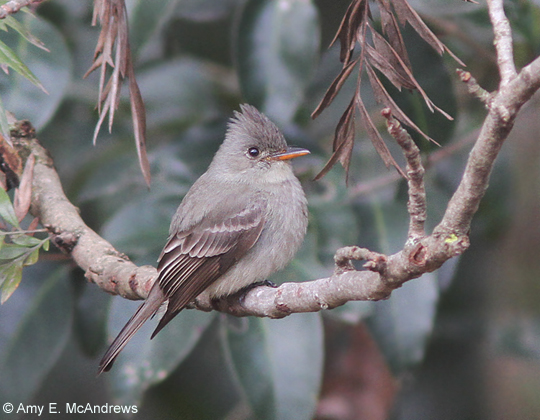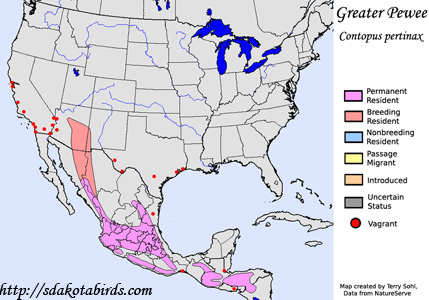| Length: 8 inches | Wingspan: 13 inches | Seasonality: Non-resident in South Dakota |
| ID Keys: Obvious crest, gray overall with lighter belly, orangish lower mandible on bill, indistinct gray wingbars | ||
 The
Greater Pewee is a large, very plain pewee species of the southern Arizona
and New Mexico, as well as further south in Mexico and Central America.
In the United States, they are only present during the summer breeding
season.
The
Greater Pewee is a large, very plain pewee species of the southern Arizona
and New Mexico, as well as further south in Mexico and Central America.
In the United States, they are only present during the summer breeding
season.
Habitat: Found in semi-open forest and woodland, including pine and pine-oak forests, as well as riparian trees such as sycamores and cottonwoods.
Diet: Feeds on insects.
Behavior: Forages in flycatcher fashion, by observing from a perch and flying out to capture insects in midair.
Nesting: The nest of a Greater Pewee is a cup of grasses, leaves, weed stems, and roots, placed in the fork of a tree. The outside is typically decorated with lichen. The female usually lays 3 or 4 eggs, and both parents help to feed the young when the eggs hatch.
Song: The song of a Greater Pewee is a series of deliberate, clear whistles. The song of the Greater Pewee has earned the species the nickname "Jose Maria" in Mexico, a rough approximation of the beautiful whistled phrases.
Migration: Considered a permanent resident throughout much of its range in Mexico and Central America. Those in Arizona and New Mexico migrate southward for the winter, although occasionally a handful will overwinter.
Interactive eBird Map: Click here to access an interactive eBird map of Greater Pewee sightings
Similar Species: The most similar species in size and structure is the Olive-sided Flycatcher, but that species is easily differentiated by its "vest" look underneath. The Western Wood-Pewee may be found in the same geographic area and is similar in overall appearance, but is significantly smaller.
Conservation Status: Populations are seemingly decreasing, but they are found over a wide geographic area and are still common in some areas. The IUCN lists the Greater Pewee as a species of "Least Concern".
Further Information: 1) BirdLife International - Greater Pewee
2) Cornell's All About Birds - Greater Pewee
3) USGS Patuxent Bird Identification InfoCenter - Greater Pewee
Photo Information: Photo taken by Amy McAndrews - February 11th, 2011 - Xalapa, Veracruz, Mexico - Photo licensed under Creative Common Attribution NonCommercial NoDerivs 2.0 Generic License.
| Click below for a higher-resolution map |
 |
| South Dakota Status: Non-resident in South Dakota |
Additional Greater Pewee Photos (coming soon!!)
